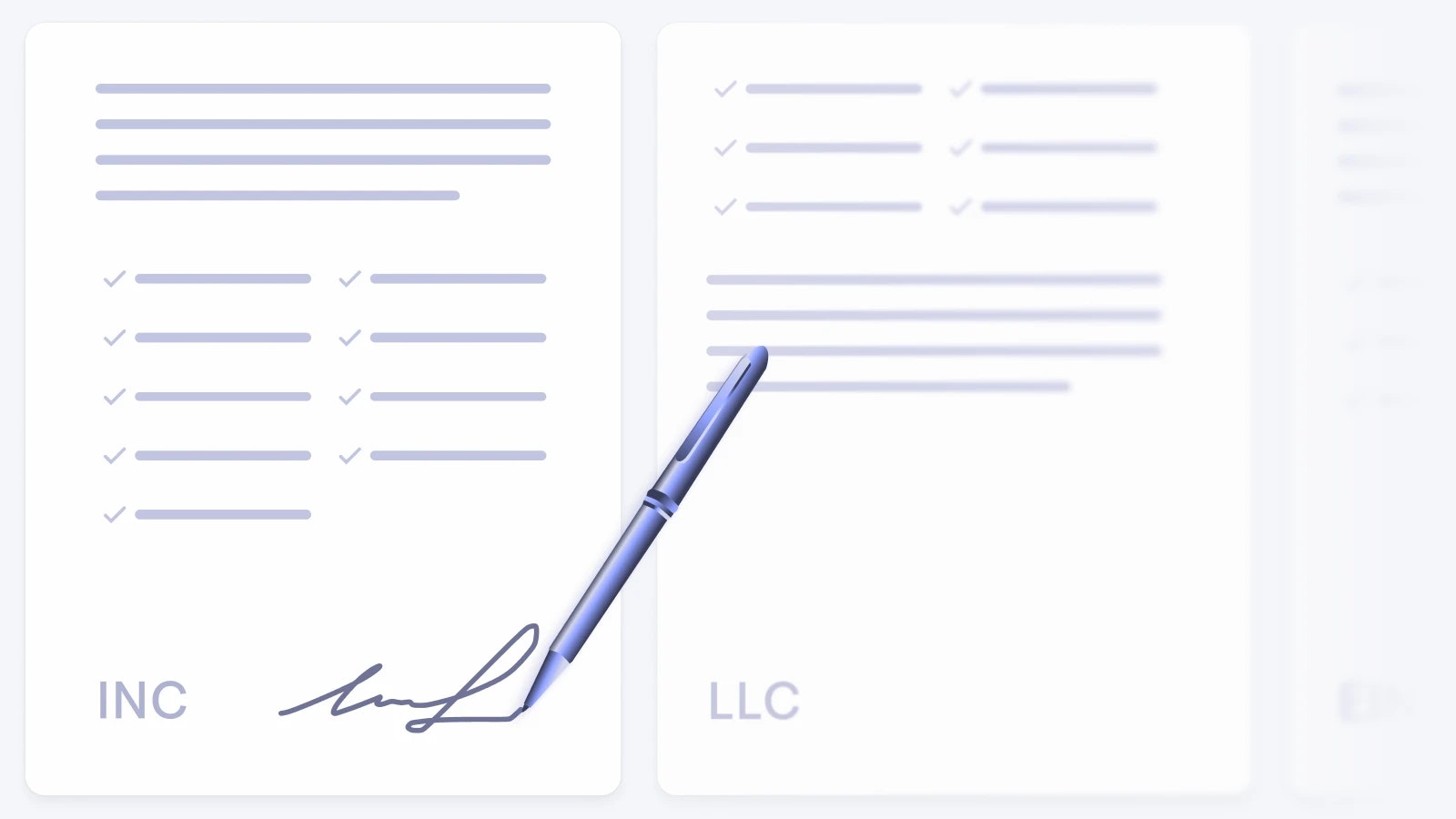How to start a U.S. ecommerce business

If you’re thinking about starting a U.S. ecommerce business, you’ll have many decisions to make, from the number of products in your initial launch to the type of business structure that fits with your company’s goals. Many of these early decisions can have a long-term impact on your business, so it’s important to think through the logistics, timing, and any financial considerations.
In this article, we’ve outlined everything you need to know to navigate these steps along with a few key takeaways.
Key takeaways
No two businesses are the same. The research you conduct to open your business in the U.S. should be checked (and double checked). We’ve outlined a few key takeaways to help you get started on your journey:
- Do thorough research before you launch an ecommerce business, including market research and financial planning.
- When you name your company, product, or service, ensure it is not already trademarked in the U.S.
- Check the required steps in your state when hiring a registered agent, filing for incorporation, registering for an EIN, and setting up a U.S. business address
- Think carefully before designing your website and logo, and bring in professional help when you need it
Getting started with your business idea
The ecommerce market in the U.S. is a $1.8 trillion market, with expected compound annual growth of 5.87% through 2028. It’s also an intensely competitive market, with more choices for online shoppers and large companies like Amazon and Walmart that dominate the landscape.
Turning your idea into an ecommerce business requires some careful planning, before you get to the steps of setting up a legal entity and launching your business online.
1. Identify your business
Your business might be harder to launch if you start with a big idea: lots of products and a wide-ranging market. You’ll face more competition and may not be able to compete with large companies that can produce products at scale. Instead, you may want to start with a niche that you can expand later.
Take Beardbrand, for example. The company launched in 2014, selling beard care products to men. After marketing its beard products and becoming well-known for high-quality beard care, the company expanded into hair care, body products, and fragrances. Today, the company does more than $7 million annually in sales.
Whatever you choose, make sure you are passionate about the products. After all, it’s a business you’ll be working in day in and day out for a long time.
2. Conduct market research
Whatever product you have in mind, you’ll want to confirm that it’s a viable business. Not only do you need to understand your potential buyers, but you also need to confirm that they’re willing to pay for your product (at your desired price point).
When conducting market research, you’ll want to answer these questions:
- Who is my target customer? (Be as specific as possible)
- How many potential customers are in my target market?
- Who is my competition, and what are they doing?
- What sets me apart from the competition?
If possible, interview potential customers, conduct a survey, or provide samples of your product to collect feedback. Find channels where your customers hang out (such as social media platforms, forums, or in-person events) to collect additional information.
3. Consider order fulfillment and customer service
How will your product be manufactured? How much inventory will you maintain? When a customer places an order, how will you get the product in their hands? What happens if a customer has a question or an issue?
These are issues that you’ll need to think about in advance of launching, because the minute a customer hits “buy” you need to be ready.
Depending on the product, you might be making the goods yourself, in which case you need to consider your capacity and speed. You might also hire a manufacturer or work with a wholesaler. Dropship suppliers are also an option. A lot will depend on your budget, expected quality, and how much control you want to have over the process.
International orders: You’ll need to determine if you’ll ship outside of the U.S. or not, and factor that into your shipping costs and shipping times.
If you’re working with a dropshipping supplier outside of the U.S., you’ll also need to consider shipping speed when you place an order.
4. Write a business plan
Many founders have to write a formal business plan in order to get financing for their business, whether it’s through an investor, a bank loan, or another source.
You should write a business plan, even if you plan to bootstrap your ecommerce business. Doing this will help you clarify your overall business strategy and put some numbers around your expected sales, income, and expenses for your business.
A typical business plan includes:
- A company overview
- Market analysis
- Descriptions of products and services
- Operations information about the business
- A financial plan, including projections and break-even analysis
- Disaster planning
You can check out these business plan examples from the Small Business Administration as well as these templates from Microsoft.
Read more: Alternative financing options for startups.
How to open a new company in the U.S.
When opening a company in the U.S., building a solid foundation can ensure your long-term success. We’ve outlined the steps you need to follow below.
1. Choose which type of business entity to form
Choose a business structure that fits your goals. The legal structure you choose will impact your registration requirements, how much (and how) you pay in taxes, and your personal liability or risk. We’ve outlined common business structures and their benefits for international business owners:
- C-corporation: C-corporations, commonly known as corporations, are separate legal entities from their owners. They consist of shareholders, a board of governors, officers, directors, and employees. Most business owners choose to incorporate their businesses because corporations offer unlimited stock and are typically more attractive to outside investors.
- S-corporation: S-corporations can only be created by U.S. residents. They offer the same advantages as traditional corporations but with more tax flexibility. In an S-corporation, profits and certain losses can avoid corporate taxes, which are instead passed through to business owners' personal income tax.
- Limited Liability Company (LLC): An LLC is a hybrid between a C-corporation and a partnership. LLCs are legally separate entities from their owners and limit personal liability. LLCs have flexible taxation, meaning that business owners can choose to pay business taxes on their personal income or pay as S-corporations.
After submitting your registration requirements, the government will review your information and decide whether to approve your business. This process can take days to months depending on factors like the state you’ve registered in and whether you’ve opted to pay an extra fee for expediting processing.
2. Register your company name
Once you've chosen a company name that your team is on board with, check if it’s being used by other businesses. All U.S. businesses have the legal right to protect their name from other businesses, and it’s important to establish that you’re not encroaching on another company’s territory. This is also a good time to check with the state you are operating in for rules on how to register your business name. Registration may be a legal requirement depending on your business structure and location.
There are four different ways to register your business name, each of which serve a different purpose:
Trademark
A trademark can protect your business, goods, or services at a federal level by preventing others in the same or similar industries from using your name or logo. Without a trademark, another business can claim your name and logo before you do. That means they will own the associated legal rights and can even sue you for using them.
For example, if you run an online coffee subscription service called Ana’s Coffee Beans and one of your products is called Rise and Shine, you must trademark both of those names to prevent other coffee businesses from using them. Your trademark will also protect your logo from being used by other businesses.
All businesses in the U.S. are liable for trademark infringement, which can be costly. To keep yourself in the clear, search the U.S. trademark database for currently registered names for all businesses, goods, and services.
Entity name
In some states, entity names are required in addition to trademarks. States identify your business through an entity name. They protect the name of your business within the state you’ve registered in—with a few exceptions. Some states ask that your entity name reflect the type of business you have (e.g., Ana’s Coffee Beans).
Doing business as (DBA) name
Also known as a trade name, fictitious name, or assumed name, a DBA name is a registered name that a business operates under that isn't its legal business name.
You might opt for a DBA if you have registered a formal business entity, but are looking to brand your products and services under a different name. For example, John's Baked Goods might go by John's Cookies. Many states require you to register a DBA if you use one.
A DBA doesn’t provide legal protection by itself, and trademark infringement laws can still apply. But because more than one business can go by the same DBA within a state, you have fewer restrictions on the name you choose and how it relates to your business. For example, a small business owner could use Ana’s Coffee Beans for its entity name but use Brew & Sip for their DBA.
Domain name
Also known as your website address or URL, a domain name helps establish an online presence for your business. It doesn’t need to match your legal business name, trademark, or DBA. Once you register your domain name, it can not be used by anyone else for as long as you own it.
Domain names are registered through accredited registrars or website builders (more information on this in step #9), and need to be renewed on a regular basis.
3. Get an EIN
An EIN is a nine-digit code that identifies your business for tax purposes. EINs are a requirement for several important business procedures, including registering your company as an LLC or corporation, hiring employees and contractors, and opening a business bank account.
Getting an EIN is relatively easy. The IRS provides a free online registration service to set up an EIN for your business.
The EIN can act as a valid Taxpayer Identification Number (TIN). If you have already registered for a separate TIN in the past, you can still apply for an EIN on behalf of your business, but it must be by mail or fax (where the form asks for the Taxpayer Identification Number, enter foreign/none).
If you’re located outside of the U.S., you can still apply for an EIN if your business is incorporated in the U.S. However, if your principal place of business is outside of the U.S., you can’t apply online. You’ll need to call the IRS or apply by mail.
Read more: How to register for an Employer Identification Number (EIN).
4. Select a state to form your business in
Choosing where to form your company is an important decision. Every business is different, and there are several factors to keep in mind when making your choice. Remember that you can do business outside of the state you form your business in, but you’ll have to keep track of varying tax rates and compliance rules across states.
Let’s say you own a skateboard company. You might want to look at:
- Demographics: Los Angeles is often cited as the headquarters of skating in the U.S.
- Competition: Texas also has a thriving skateboard scene, with less competition than in California
- Supply chain: Nevada offers affordable, accessible skateboard manufacturing options
- State taxes: Delaware is a famously low-burden tax state for businesses
- State laws: Alabama has made it illegal to skateboard in commercial areas
Your decision should meet your company’s business objectives in a cost-effective manner without sacrificing the quality of the goods or services you provide.
5. Get a registered agent
A registered agent’s role is to receive legal documents for your company within the U.S. The state you’ve registered in will send your agent annual reports and tax notices, as well as other important legal notices that require urgent action. State laws require corporations and LLCs to maintain a registered agent in every state in which your company does business.
A registered agent may be a member of your company who has a physical address in a state where you’re doing business—with the exception of California, the only state that requires a third party agent. Even in states where company members are allowed to be registered agents, many choose to go with a third party, like a lawyer. If your company fails to properly maintain a registered agent, you might miss an important legal notice or tax filing document, impacting your ability to do business.
A registered agent service will typically:
- Receive and forward any official documents or tax notices from the Secretary of State to your company
- Accept any legal service of process and forward it to your company
Some registered agents are more knowledgeable and are better fits for your business. It’s important to research the right agent before making a decision: shop around, ask questions, and learn what average costs are in your state.
6. File articles of organization
Once you’ve found a name for your business and selected a registered agent, the next step is to form your business. Many ecommerce businesses form LLCs. The benefits of LLCs include a flexible taxation structure and personal liability protection, which protects your personal assets if your business encounters an accident it can't pay for.
LLCs are formed by filing documents known as articles of organization with the Secretary of State in your chosen location. Articles of organization will ask for your business name, the name and address of your registered agent, and your LLC's management structure—either member-managed or manager-managed.
You should form an LLC in the state you plan to do business in. If your LLC plans to do business outside of its registered state, you will have to register a foreign LLC.
Depending on the state, your LLC will cost between $40 to $500 to form. You will also have annual fees which differ by state. Processing times can vary depending on factors like the state you form your business in, the time of year you file, and how complete your articles of organization are. You can pay an extra fee to expedite filing.
You can also hire an LLC formation company like ZenBusiness or LegalZoom. In some states, you will also have to create an operating agreement, which outlines your LLC's ownership structure and the roles of different members. Although this isn't a requirement in all states, operating agreements are often recommended to have as sources of truth.
7. Arrange a U.S. business address or virtual office
A U.S. business address can legitimize your operations. Your address can be used for mail and to set up company accounts. While you may be tempted to use your registered agent’s address to receive mail, this is not the agent’s intended use. As you select a physical address, keep in mind that some states allow you to use a mailbox service’s physical address, including a P.O. box, while others do not.
Virtual offices, also known as co-working spaces, offer a professional mailing address to use as your principal place of business, with additional perks such as a phone number, receptionist services, meeting spaces, workspaces, and mail forwarding services. Many virtual offices offer international mail forwarding, if you are doing business in the U.S., but living in another country.
8. Open a U.S. bank account
A business account that fits your unique needs can empower your business, complement the way you interact with customers and vendors, and allow you to stay legally compliant and protected.
Some key factors to review before choosing a banking service include rewards, access to online services, the convenience of making deposits, and the ability to earn interest rates on your deposits. You should keep separate accounts for personal and business use. Separate business and personal accounts can sometimes be required by the state.
9. Build a website and design a company logo
It’s easier than ever to create a website for your business, regardless of your technical skill level. The most common method is to use a website builder, such as Wix, Weebly, or Shopify. Website builders take care of the back end development and let you focus on design and content, often through templates and drag-and-drop interfaces. Some website builders also let you register a website name.
Once you’ve chosen a website builder that’s right for you, there are a few more steps you’ll need to follow:
- Sign up for a monthly or annual plan that suits your business needs and budget
- Register your domain name or use one you’ve purchased on a different site
- Pick a design template that speaks to your brand
- Customize your template design, using online tutorials when needed
- Upload and format copy and content that clearly explains your value
- Preview and test your website with feedback from trusted third parties
- Publish your website
If you’d like to create a website with more complex technical abilities or design is not your strong suit, you can find a well-reviewed web developer on a reputable freelance services marketplace like Freelancer, Upwork, or Fiverr.
Looking for help setting up your business?

Next steps: Marketing your product
Once you’ve established your business and website, you’ll want to think about how you’ll start to acquire customers.
Even if you don’t plan to use social channels immediately, you should at least claim the handles for the major platforms, such as a LinkedIn Page, Facebook Page, Instagram profile, and X/Twitter profile.
Some ecommerce businesses grow organically through engaging content on social channels (like video), while others rely on other techniques such as search engine optimization (SEO) or paid advertising. You’ll also want to set up email marketing so you can reach past customers and other people who sign up for your mailing list.
You may also consider listing your products on sites like Amazon or Etsy, in addition to your own website. Though these platforms take a fee for every sale, they can expose you to a much larger audience of potential buyers.
Every ecommerce business is truly unique. If you don’t have experience in marketing, consider hiring a fractional marketing consultant to help you figure out the best tactics for your business. A consultant can make sure you’re spending money on the right channels, so you can reach profitability faster.
Read more: Creating a go-to-market strategy for your launch
Want to hear directly from an ecommerce founder? Watch our video with Mango Puzzles co-founders Kemal Didić and Svet Lovoukhin on getting their business started:
FAQs
What is the best business structure for an ecommerce company?
The best structure depends on the goals of your business. An LLC offers a balance of liability protection and tax flexibility, while a C Corporation is better if you plan to raise venture capital.
Do I need an LLC or a corporation to start an online store?
No, you can start an online store as a sole proprietor, though an LLC or corporation offers you more protection from liability.
How much money do I need to start an ecommerce business?
If you plan to form an entity, you may need a few hundred to a few thousand dollars to cover legal costs. You’ll also need to pay for website development and have enough initial inventory to cover orders.
Do I need a business license to sell online?
A business license or permit depends on the product you are selling and the state. Check local laws to be sure.
What are the best platforms for building an ecommerce website?
The best platforms are Shopify, Wix, WooCommerce, and Squarespace.
How do I find reliable suppliers or manufacturers for my products?
You can use websites like Alibaba and CJdropshipping, which include ratings and review for suppliers and manufacturers.
How can I legally sell products in the U.S. as an international entrepreneur?
To sell products in the U.S., you’ll need to form a U.S.-based entity, obtain an EIN, and comply with federal, state, and local regulations.
What’s the difference between dropshipping and holding inventory?
Dropshipping means the supplier ships products directly to your customers. Holding inventory means you purchase and store products yourself to fulfill orders.
How do I market my eCommerce business and get my first customers?
Every ecommerce business is different, but you can start by promoting your store on social media, optimizing content for search engines (SEO), running targeted ads, and building an email list to reach potential customers.
What are the biggest mistakes new eCommerce entrepreneurs make, and how can I avoid them?
Some ecommerce founders skip market research and don’t truly understand the target customer. Others underestimate costs, which can be avoided with careful financial planning.



